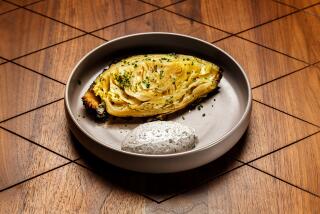Cabbage No Longer King in China
- Share via
BEIJING — The Chinese cabbage is everywhere. It’s piled in small mountains throughout this teeming capital. It’s being lugged into homes, to be stored for the winter. In the alleys, mounds of discarded, rotting cabbage leaves are being slowly trodden into a light green sludge.
The annual botanical ritual of the “patriotic” cabbage has begun.
Why patriotic? Because it is one of the last vegetables the state still subsidizes and because the government once encouraged people to eat it out of a sense of civic duty. But now, with food production booming, many Chinese see this vestige of the centrally planned socialist economy as something alien.
“Who buys cabbage anymore?” scoffed Cai Dui, a translator for a foreign multinational company. “Most of it rots before you can use it.”
Less than a generation ago, Beijing got through the winter mostly on cabbages (bai cai in Mandarin, bok choy in Cantonese, literally “white vegetable”) and a few radishes and potatoes. Residents had even less to eat during the massive famine of 1959-60, when millions of Chinese starved to death.
By contrast, today’s private-sector market stalls are brimming year-round with an abundance of grains, greens, tubers and other produce, much of it shipped from southern China.
China’s shift to a market economy has meant that cities that once strove for food self-sufficiency have become increasingly dependent on free-market interaction with other regions, according to Andrew Watson, an expert on China who has examined cabbage distribution as a microcosm of the nation’s economic reforms.
Watson says the process highlights the difficulty that China has had in liberalizing agricultural production and, at the same time, keeping prices and inflation down.
This year, for example, Beijing’s municipal government spent about $2.4 million to subsidize the city’s onslaught of cabbage, which traditionally occurs during the first week of November. State-owned food stores received 10,000 tons of cabbage, plus subsidies to keep their prices down to around 1 cent a pound. At other times of the year, it sells for about 10 cents a pound.
Suburban peasants received $1.9 million in subsidies to produce and transport their 27,000 tons of cabbage into the capital. Without the subsidies, peasants would probably desert their unprofitable cabbage patches in favor of commerce and industry. Already, luxury villas, golf courses and racetracks are sprouting from suburban fields where vegetables once grew, and local officials are scurrying to protect farmland from overdevelopment.
“This is the last year I bother with this stuff,” farmer Lu Bian griped as he shored up a 10-foot-high wall of cabbages for sale near Beijing’s Forbidden City. “Next year, I’m renting out my land for someone else to farm.”
The remaining cabbage farmers have had to adapt by upgrading their storage, transportation and marketing capabilities. They often grow their produce in greenhouses and invest in refrigerators to store it until prices are higher.
Unable to compete with more upscale greens from the south, the homely crucifer is slowly disappearing from the menus of the capital’s restaurants. Broccoli, snow peas and lettuce, unknown in the north before the early 1990s, have now become standard fare.
Nevertheless, the vitamin-rich plant is still a mainstay of northern China’s winter home cooking. In addition to using cabbage in soups, salads, stir-fried dishes, Mongolian hot pots and dumpling fillings, Chinese traditionally convert it into kimchi and sauerkraut, which are easier to store.
Younger, wealthier city dwellers can’t be bothered to buy, carry and store cabbages. Most of them are accustomed to purchasing convenience foods such as frozen dumplings and instant noodles.
But many of their parents’ shopping habits were shaped by years of scarcity and rationing. Older residents of Beijing, most of whom get by on less than $200 a month, habitually buy vegetables when they are in season and at their cheapest.
“April is spinach month,” noted Li Xian, a retired professor. “After eating the stuff for a month, I’m so sick of it I can’t touch it until next April.”
More to Read
Sign up for Essential California
The most important California stories and recommendations in your inbox every morning.
You may occasionally receive promotional content from the Los Angeles Times.













